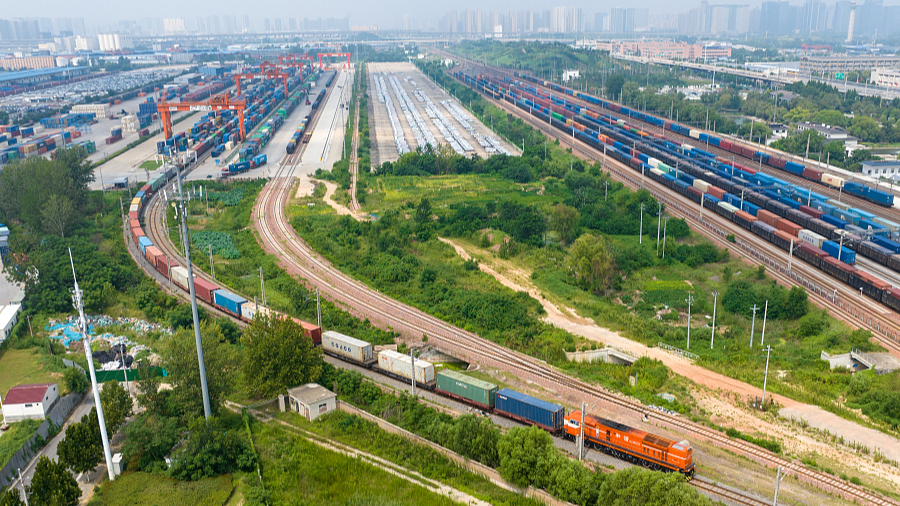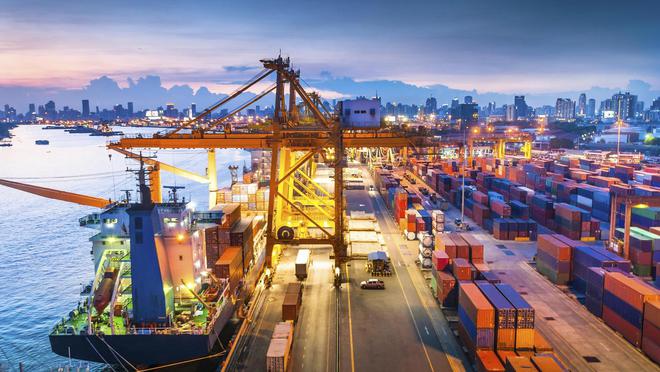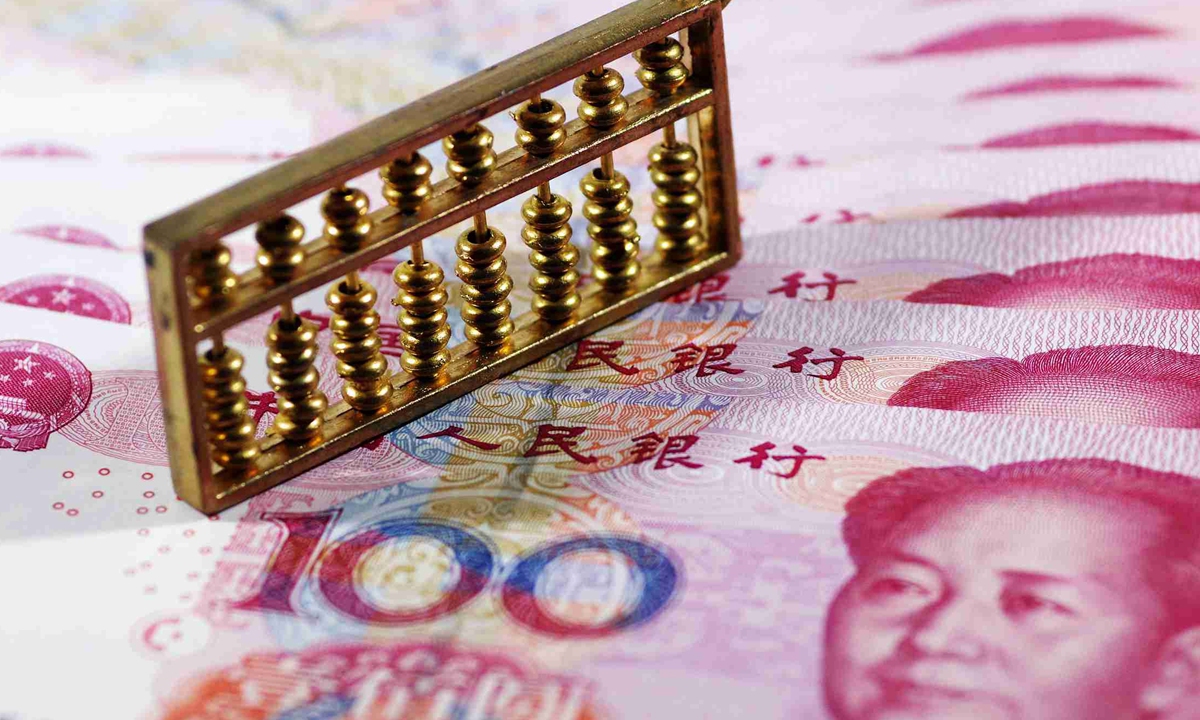
A China-Europe Railway Express freight train departs from Zhengzhou International Land Port, Zhengzhou, central China's Henan Province, August 11, 2023. /CFP
More and more freight forwarders have turned to the China-Europe Railway Express (CRE), an extensive network of rail services connecting China and Europe, as a transportation alternative amid the Red Sea crisis, which has disrupted international shipping.
Experts say the increased use of the network has highlighted the rail route's vital role in stabilizing global supply chains.
Houthis in Yemen have been attacking commercial ships "affiliated with and bound for Israel" since November. The attacks have raised the risks for transportation companies moving cargo through one of the world's busiest shipping lanes, resulting in a surge in rates and lengthy delays.
According to a recent report by Fitch Ratings, the capacity of the CRE has seen a significant expansion from pre-crisis levels. Kong Weidong, head of the Zhengzhou branch of T.H.I. Group (Shanghai) Ltd., a freight forwarder, noted a remarkable increase in inquiries about the China-Europe freight train service since the beginning of the year.
"Since January, the number of inquiries has soared more than tenfold, and the actual export volume of goods has increased by three to four times," Kong said. According to Kong, the China-Europe rail freight service typically takes between 12 and 18 days to reach European destinations from Chinese cities, at a cost of approximately $6,500 per container.
Kang Yingfeng, deputy general manager of China Railway International Multimodal Transportation (CRIMT), the national operator of the China-Europe freight train service, also noted a significant increase in inquiries about the China-Europe freight train service since January.
Big international logistics firms like DHL and Kuehne Nagel have shown great interest in a new China-Europe freight route, combining rail and ocean transportation that crosses the Caspian and Black seas, Kang said. The network also passes through countries such as Kazakhstan and Georgia before reaching European countries.
DHL told The Financial Times last month that requests for goods transportation via the rail service to Russia had risen by about 40 percent since container ships began diverting via longer routes in December via the Cape of Good Hope, the southern point of the African continent.
Fu Cong, China's ambassador to the European Union, stated in an article published on Euractiv, a European news website, that around 60 percent of China's exports to Europe relied on the Red Sea route before the outbreak of the crisis, but now that 90 percent of those container ships from China have been forced to reroute via the Cape of Good Hope, which increases a minimum 12-day delay in shipping time.
He added that under such circumstances, many businesses began to consider using the CRE. "With the decline of freight volume in the Red Sea, this land route has bucked the trend to see strong growth. Inquiries made to the railway express have almost doubled. Most container service providers predict that railway transportation will grow dramatically in the years ahead," Fu said.
During a recent interview with China News Service, Hannes Fellner, a professor from the University of Vienna, said the CRE plays the role of "stabilizer," ensuring the security of international supply chains amid the Red Sea crisis.
Fabio Massimo Parenti, professor of international studies at the International Institute Lorenzo de' Medici in Florence, said that the CRE is a partially complementary alternative to the maritime routes and "an example of the importance of the Chinese ideas where China is investing along with other countries." He added that more than 200 cities in Europe benefited from the CRE.
By the end of February 2024, the CRE network had expanded to cover 219 cities across 25 European countries, according to data from China Railway.
由于红海危机,国际航运受阻,越来越多的货运公司转向中国-欧洲铁路快运(CRE)作为一种交通替代方案。专家指出,这一铁路网络的使用增加突显了其在稳定全球供应链方面的重要作用。
也门胡塞武装自11月以来一直在攻击与以色列有关的商船,增加了通过红海航线运输货物的风险,导致船运费用上涨和延误增加。
太平集团郑州分公司负责人货运代理集团(上海)有限公司注意到,自年初以来,有关中欧班列服务的询问量显着增加。
“一月份以来,询盘数量猛增十倍以上,货物实际出口量增长了三到四倍。”据孔介绍,中欧铁路货运服务通常需要12至18天才能从中国城市到达欧洲目的地,每个集装箱的成本约为6,500美元。
中欧班列全国运营商中铁国际多式联运(CRIMT)副总经理康迎峰也指出,自1月份以来,中欧班列的咨询量大幅增加。
DHL和Kuehne Nagel等大型国际物流公司对一条新的中欧货运航线表现出了极大的兴趣,该航线结合了穿越里海和黑海的铁路和海运。该网络还经过哈萨克斯坦和格鲁吉亚等国家,然后到达欧洲国家。DHL上个月告诉英国《金融时报》,自去年12月集装箱船开始改道经非洲大陆南端好望角的更长航线以来,通过铁路服务运往俄罗斯的货物需求增加了约40%。
中国驻欧盟大使傅聪在欧洲新闻网站Euractiv发表文章称,危机爆发前,中国对欧洲的出口约有60%依赖红海航线,但现在90%其中来自中国的集装箱船被迫改道经好望角,这导致运输时间至少延迟 12 天。他补充说,在这种情况下,很多企业开始考虑使用CRE。“随着红海货运量的下降,这条陆路航线却逆势强劲增长。铁路快运的询价几乎翻了一番。大多数集装箱服务提供商预计,未来几年铁路运输将大幅增长。”
维也纳大学教授汉内斯·菲尔纳日前接受中新社采访时表示,中欧关系在红海危机中发挥着“稳定器”作用,确保了国际供应链的安全。佛罗伦萨洛伦索·德·美第奇国际研究所国际研究教授法比奥·马西莫·帕伦蒂表示,中欧陆路是海上航线的部分补充替代方案,“是中国与其他国家一起投资的中国理念重要性的一个例子”。他补充说,欧洲有 200 多个城市受益于 CRE。
中国铁路总公司的数据显示,截至2024年2月,中铁网络已覆盖欧洲25个国家的219个城市。













